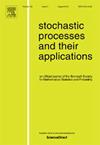Profile cut-off phenomenon for the ergodic Feller root process
IF 1.2
2区 数学
Q3 STATISTICS & PROBABILITY
引用次数: 0
Abstract
The present manuscript is devoted to the study of the convergence to equilibrium as the noise intensity tends to zero for ergodic random systems out of equilibrium driven by multiplicative non-linear noise of the type where , and are constants, and is a one dimensional standard Brownian motion. More precisely, we show the strongest notion of asymptotic profile cut-off phenomenon in the total variation distance and in the renormalized Wasserstein distance when tends to zero with explicit cut-off time, explicit time window, and explicit profile function. In addition, asymptotics of the so-called mixing times are given explicitly.
遍历费勒根过程剖面切断现象
本手稿致力于研究收敛到平衡的过程,因为噪声强度[>;0]趋向于零,对于由类型为dXt æ (x)=(b - aXt æ (x))dt+ [Xt æ (x)dBt,X0 æ (x)=x,t或大于或等于0的乘法非线性噪声驱动的遍历时随机系统,其中x或大于或等于0,a>;0和b>;0是常数,而(Bt)t或大于或等于0是一维标准布朗运动。更确切地说,当具有明确的截止时间、明确的时间窗和明确的剖面函数时,我们在总变差距离和重归一化Wasserstein距离中证明了渐近剖面截止现象的最强概念。此外,明确给出了所谓混合时间的渐近性。
本文章由计算机程序翻译,如有差异,请以英文原文为准。
求助全文
约1分钟内获得全文
求助全文
来源期刊

Stochastic Processes and their Applications
数学-统计学与概率论
CiteScore
2.90
自引率
7.10%
发文量
180
审稿时长
23.6 weeks
期刊介绍:
Stochastic Processes and their Applications publishes papers on the theory and applications of stochastic processes. It is concerned with concepts and techniques, and is oriented towards a broad spectrum of mathematical, scientific and engineering interests.
Characterization, structural properties, inference and control of stochastic processes are covered. The journal is exacting and scholarly in its standards. Every effort is made to promote innovation, vitality, and communication between disciplines. All papers are refereed.
 求助内容:
求助内容: 应助结果提醒方式:
应助结果提醒方式:


